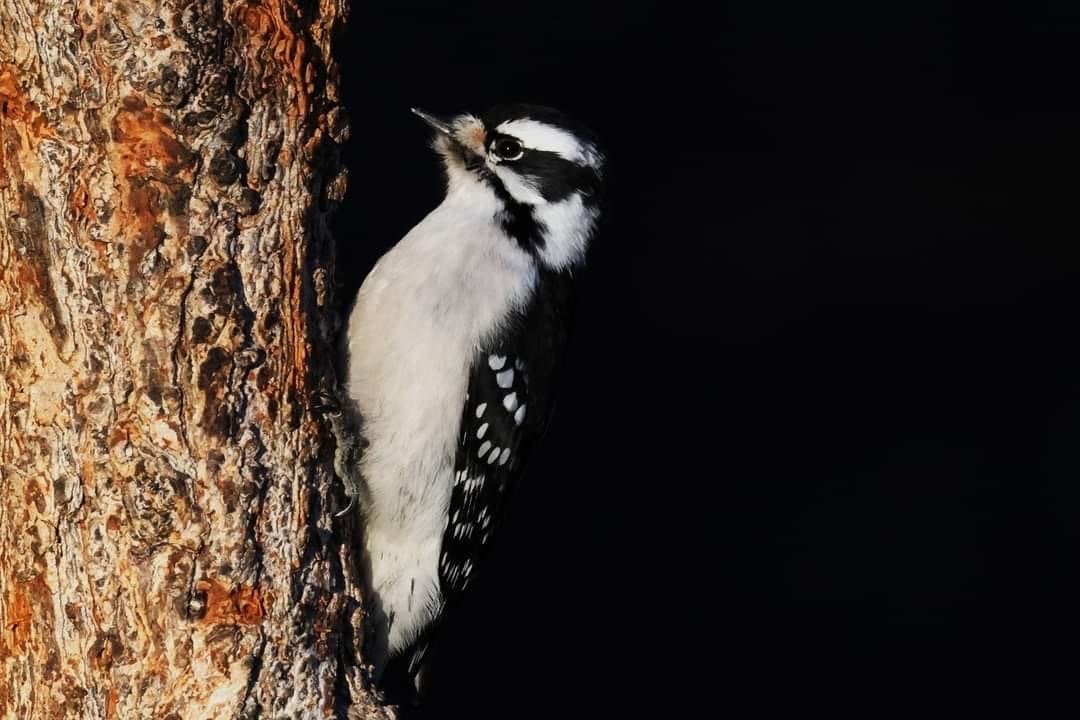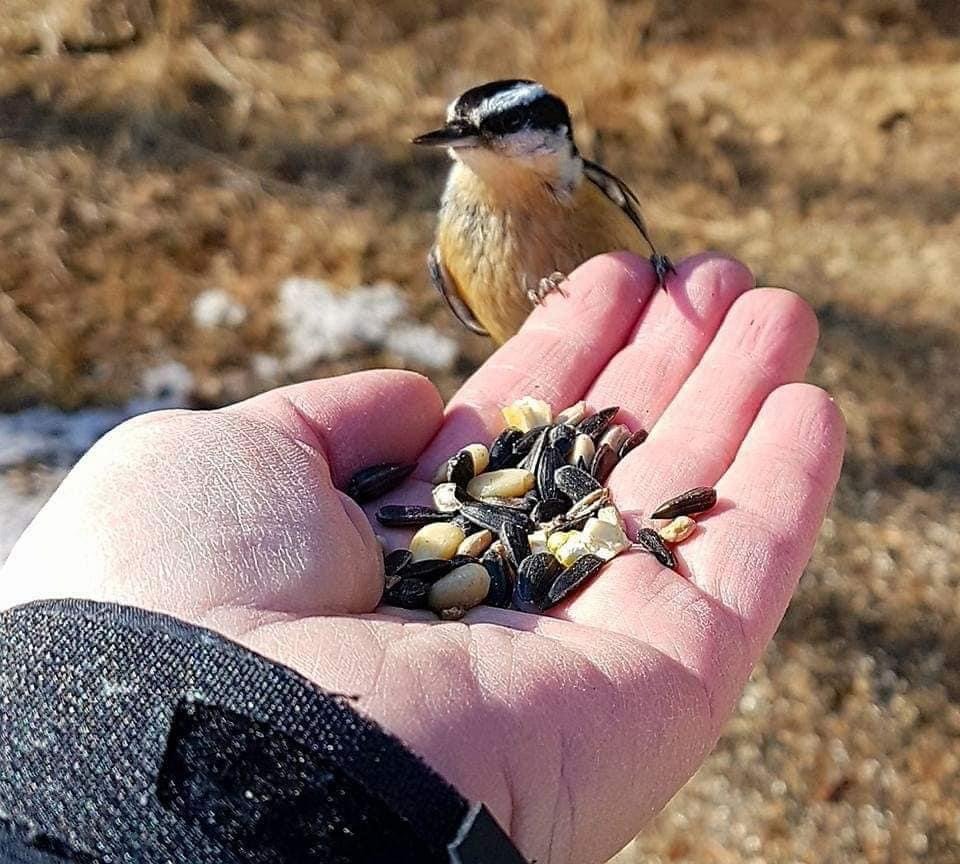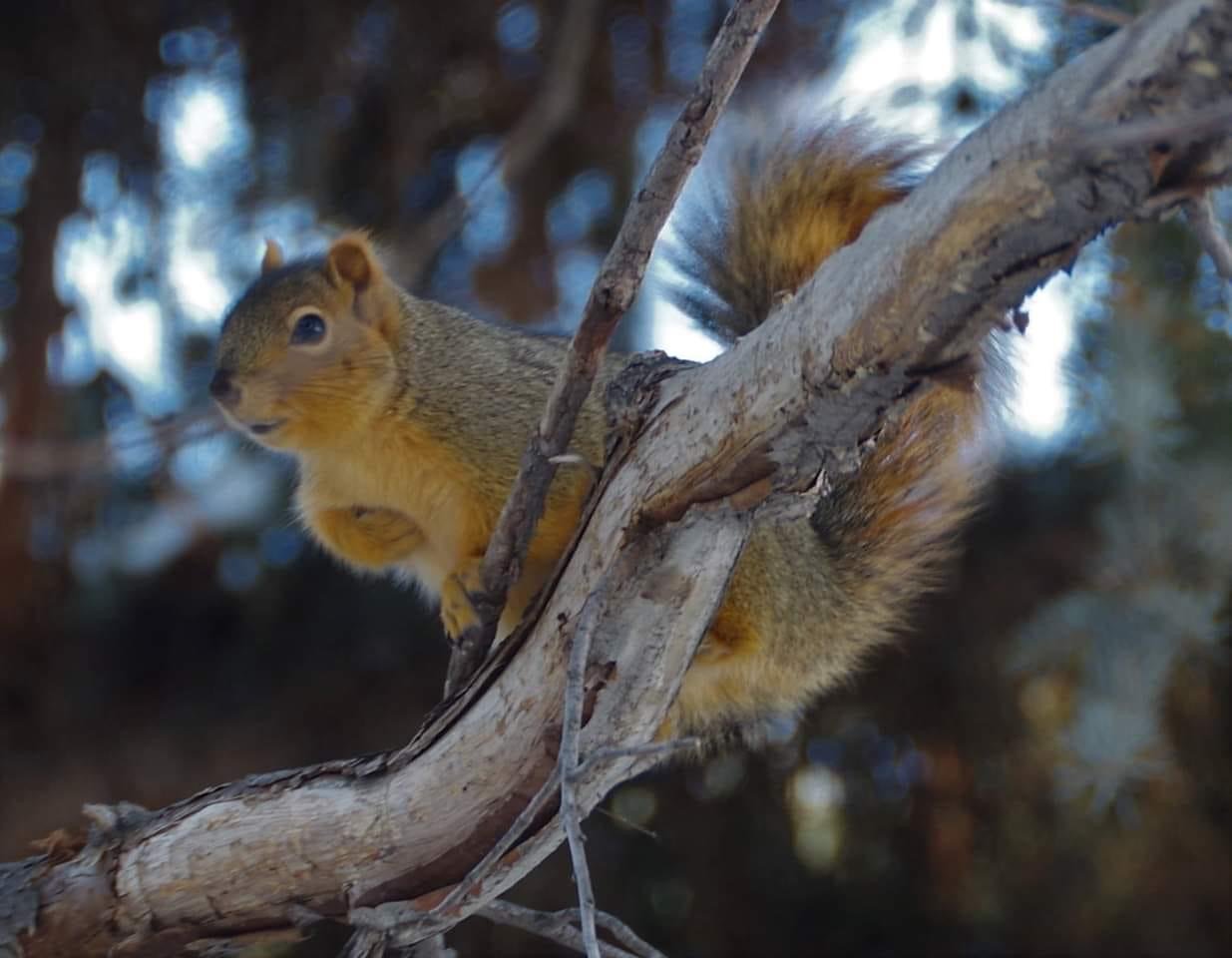"Decorate a Tree For Wildlife" 🌲🐦🐿🦌"Beyond Your Backyard"🌲
By Kimberly J Epp
The weekend is upon us, so perhaps you are looking for an activity to keep the kids busy over the holidays. Perhaps you would like to begin a new family tradition.
Look no further, as here is an activity that gets the whole family interested in birds and other wildlife, and it can become a fun new tradition. So, why not decorate your tree for the wildlife?
Patti Kosteniuk fills the fruit feeder with our freshly made suet filling. Grapefruits, oranges, coconuts, and other fruit can be used. Always do your research to ensure the fruit you use is okay for the birds.Although it's currently mild, it won't stay that way. In winter, birds require more energy to maintain their body temperatures.
Finding energy-rich foods such as peanut butter and suet (beef fat) provides the extra calories birds need. Insects aren't readily available during the winter, so some insect eaters will turn to suet to fill that empty niche.
A grapefruit feeder filled with suet.
Last Sunday, 25 people were in attendance at the Kiwanis Lodge to learn all about the common winter birds, how to make their own feeders, and then to hand-feed (with pine nuts) and learn to identify some of the the common feeder birds at the feeder site.
The group at the feeder workshop makes feeders to decorate their trees with, some to hang at the wakamow feeders.
It was an energetic, hands-on program, and the weather couldn't have been more perfect. The late afternoon sun shone down on us when we arrived at the feeders with our treats.
Hands out. Pine nuts within. Come on, birbs! And the birbs did land, and on many a hand! The smell of the peanut butter on the treats brought them to us.
Hairy and Downy Woodpeckers, Red and White-breasted Nuthatches, Black-capped Chickadees, House Finches...even a Great Horned Owl was spotted on top of a tree! The Red-breasted Nuthatches and chickadees took many a pine nut from us, then cached them within the bark of the trees for those leaner times.
After the first chickadee landed in my hand (yes, it was trained to do so! 😄), the other birds started showing up one by one. Red-breasted Nuthatches and Black-capped Chickadees flew into open hands to get the soft protein-rich nuts while White-breasted Nuthatches watched with the intent to snag some of these newly cached nuts.
Hairy and Downy Woodpeckers soon investigated, and a female Hairy Woodpecker flew to where the peanut butter treats were hung then pecked some seeds from the top of the large feeders, giving everyone a close-up look at her.
A female Downy Woodpecker at the Wakamow feeder site. (Photo by Rich Pickering)
If you visit the feeders during a cold day, you'll see and land many birds. However, we were very lucky to have seen as many as we did, given that the birds were not fighting the extreme temperature they usually do at this time of year. A Great Horned Owl (that has been hanging around the area) was also spotted.
A Red-breasted Nuthatch perches on my fingers. I always mix some oilseed with the pine nuts as the birds will spend a couple more seconds searching on your hand for the "white gold." (Photo by Kimberly Epp)
We made bagel feeders, pine cone feeders, grapefruit (and coconut) feeders filled with suet, and milk carton feeders. Each participant received a bag of seed cookies to take home for their own trees. The feeders made were for the participants to either take home or hang up at the wakamow feeders.
Even if you were not in attendance, you can easily make your own decorative feeders at home! Many of the things that you'll need, you probably already have in your house.
A bagel bird feeder.
Like the pine cone, tie the twine on first. Then apply the peanut butter and dip it into your plate of seeds.
Try to hang the treats near to the branches for easy access,
however a chickadee can easily hang upside down on this bagel feeder. If you have bagels that are a bit old, freeze them for this activity along with any berries or pumpkin for your suet cakes.
Also save your egg shells. Wash and dry them first, then after a couple of days, you can crush them into small pieces. You can also freeze them for later use. I add them to the suet, but you also put them in your seed plate.
Why? Egg shells are high in calcium, and help the birds keep their bones, beak and feet healthy.
Nature also provides ornaments for you to use. One example is that you can collect the head clusters from foxtail grass. Be creative. There's not just one way to make each ornament. I saw a lot of creativity with the feeders made last Sunday!
🐦Read more here on hand-feeding birds here,
https://www.mjindependent.com/lifestyles/2019/11/17/yiz0talhkaklv78vu3jxu55epv8dj7?fbclid=IwAR2plnmhZoZrFhkve1PGOOr9ndM7s-R6i9iDmBRR52ftuq80qofsT_-AIuk
Birds have amazing ways of surviving the cold. Chickadees grow extra brain cells in the fall, which allows them to remember 95 percent of the places they cached their nuts and seeds within.
A pine cone feeder.
These are simple to make and can be reused once the peanut butter and seeds are gone.
First, use twine or a sofy wooly yarn like this (avoid using pipe cleaners or regular string) that the birds can use later in their nests. Then with a knife, apply unsalted peanut butter. Lastly, roll the cone in a plate of bird seed. I used a mix of oilseed, peanuts, and wild bird mix for these treats, as well as with the suet treats.
They must consume a third of their body weight each day. They will spend the long winter nights huddled together in a woodpecker hole or other cavity with their banditry family group.
Their bodies use all of the food that they have consumed during the day to keep them from freezing. They take it one step further by putting their tiny bodies into a state of near hypothermia by lowering their body temperatures to conserve body heat, which they can only do when together as a group.
Chickadees will cache (store) tens of thousands of seeds over a number of acres. Interestingly, they also have the largest vocabulary of any feeder birds, with more than 15 different calls. They are one of the friendliest feeder birds, singing even on the bleakest of days.
A Black-capped Chickadee all puffed out, traps warm air between its outer feathers and inner down-covered skin, in order to keep warm on a frigid day.
You yourself keep warm by wearing your winter coat in much the same way. You trap warm air within, preventing yourself from getting cold.
(Photo by Kimberly Epp)
🐦Read more here on how birds survive the cold here,
https://www.mjindependent.com/lifestyles/2022/1/9/2bwhzvpci1h9sq2j8jbbafg5zkg5pt?fbclid=IwAR2ncIoYtwlRZzpOOoaEs-Z2j1-ii6o4aTzkVM1uQgKMWVNLpq4h6W0nlrw
Next Sunday, December 17th, you can take part in the Christmas bird count at Wakamow. Learn more about the chickadees and other winter birds. Identify the common (and perhaps not so common) birds as you count how many of each species there are.
These counts help scientists by providing essential data on the birds - and how certain trends change year to year.
This Fox Squirrel pledges to raid every one of your feeders!
(Photo by Kimberly Epp)
Getting outside with nature is always good for the soul, so if you are interested in participating, you can contact our current President, Rich Pickering, at (306) 690-6267 for details.
Happy holidays to everyone. Thank you to all for helping out our birds and other wildlife.
🐦🐦🐦🐦🐦🐦🐦🐦🐦🐦🐦🐦🐦🐦🐦
Epp is Past President and Field Trip Coordinator of the Moose Jaw Nature Society. She is an environmental educator and writer. You can reach Epp at (306) 681-3198 or at kepp@shaw.ca - or via the MJNS Facebook page.
The MJNS meets on the third Friday of every month at the Kiwanis Lodge at Wakamow. Info on upcoming programs will be posted on the MJNS Facebook page.
During December, we held the "Decorate Your Tree For Wildlife" program as well as our yearly member's Christmas banquet at the Hopkins House - which this Sat. at 6:30 pm.
Meetings will resume in January, along with our AGM, where we will be voting on our board. Memberships are $20 per person, with children no charge.










